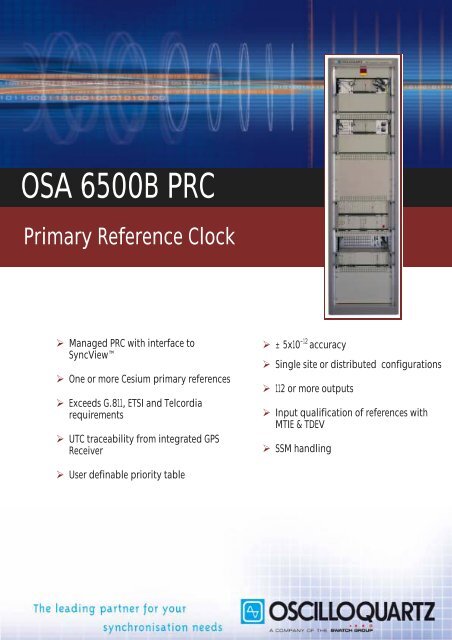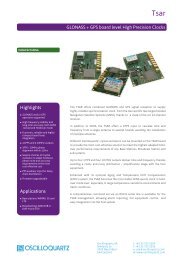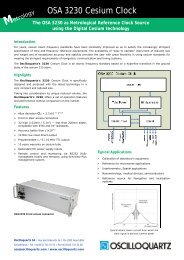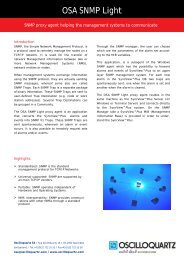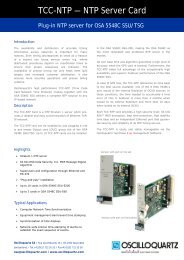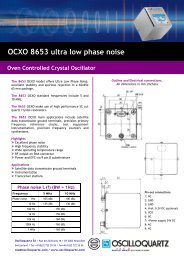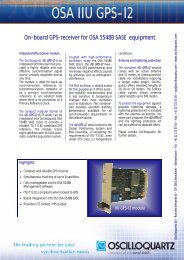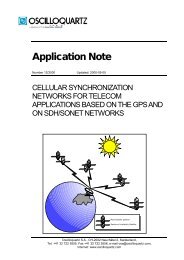OSA 6500 PRC - Primary Reference Clock - Oscilloquartz SA
OSA 6500 PRC - Primary Reference Clock - Oscilloquartz SA
OSA 6500 PRC - Primary Reference Clock - Oscilloquartz SA
You also want an ePaper? Increase the reach of your titles
YUMPU automatically turns print PDFs into web optimized ePapers that Google loves.
<strong>O<strong>SA</strong></strong> <strong>6500</strong>B <strong>PRC</strong><br />
<strong>Primary</strong> <strong>Reference</strong> <strong>Clock</strong><br />
� Managed <strong>PRC</strong> with interface to<br />
SyncView<br />
� One or more Cesium primary references<br />
� Exceeds G.811, ETSI and Telcordia<br />
requirements<br />
� UTC traceability from integrated GPS<br />
Receiver<br />
� User definable priority table<br />
� ± 5x10 -12 accuracy<br />
� Single site or distributed configurations<br />
� 112 or more outputs<br />
� Input qualification of references with<br />
MTIE & TDEV<br />
� SSM handling
Precise Quality<br />
Synchronisation significantly impacts network performance.<br />
The global demand for telecommunications is increasing at an incredible pace resulting in networks becoming more<br />
and more sophisticated. The same is true for synchronisation elements as they are fundamental to any<br />
telecommunications network. The quality and precision of clocking equipment has a significant impact on a network’s<br />
performance. Digital networks require a reliable supply of accurate and stable synchronisation.<br />
The ITU-T Recommendation G.811 states that a <strong>PRC</strong> provides the reference signal for the synchronisation of other clocks<br />
within a network. The long-term accuracy of the <strong>PRC</strong> should be maintained at one part in 1011 or better with verification<br />
to Co-ordinated Universal Time (UTC). The synchronisation reference frequency is usually generated by <strong>Primary</strong><br />
<strong>Reference</strong> <strong>Clock</strong>s (<strong>PRC</strong>s) and distributed through the network. The availability requirements of SDH based networks<br />
entails the use of multiple-site <strong>PRC</strong> systems.<br />
Flexible Approach<br />
A <strong>PRC</strong> may be an autonomous clock; alternatively, it can be a non-autonomous clock that is locked to UTC-derived<br />
signals. In either case, the requirements for long-term accuracy and short-term stability, still apply.<br />
<strong>Oscilloquartz</strong> <strong>PRC</strong>s comprise atomic Cesium clocks and/or GPS receivers as reference frequency sources. As the<br />
availability of synchronisation is crucial for the network, <strong>PRC</strong>s are implemented with redundant reference sources.<br />
Most networks are synchronised by decentralised <strong>PRC</strong>s to achieve protection against failures affecting a complete site.<br />
Today’s <strong>PRC</strong>s need to provide a flexible approach that allows the <strong>PRC</strong> to evolve as the network grows, have a reliable<br />
and resilient architecture and interface with a management platform that can manage the entire synchronisation<br />
network.<br />
GPS<br />
Caesium Receiver <strong>Clock</strong><br />
GPS<br />
Caesium Receiver <strong>Clock</strong><br />
GPS Antenna<br />
Architecture<br />
GPS<br />
Receiver<br />
Outputs<br />
Input<br />
Interface<br />
Unit<br />
Oscillator<br />
Input<br />
Output Signal Generator<br />
and<br />
Interface<br />
Unit Tracking Units<br />
Input<br />
Interface<br />
Unit<br />
Input<br />
Interface<br />
Unit<br />
Outputs
Achieves Objectives<br />
The <strong>O<strong>SA</strong></strong> <strong>6500</strong>B achieves the objectives required for<br />
distributed and stand-alone <strong>PRC</strong>s especially when the<br />
system is controlled by the <strong>Oscilloquartz</strong> SyncView<br />
synchronisation management system.<br />
A typical <strong>6500</strong>B rack comprises Cesium and GPS<br />
references, a synchronisation element, output<br />
distribution, alarms, management and power supplies.<br />
At the core of the <strong>O<strong>SA</strong></strong> <strong>6500</strong>B is an <strong>O<strong>SA</strong></strong> 5548B Stand<br />
Alone Synchronisation Element (<strong>SA</strong>SE) that handles<br />
many of the system’s primary functions. This reduces<br />
the cost of conventional <strong>PRC</strong> configurations and<br />
provides greater management capability.<br />
The <strong>O<strong>SA</strong></strong> <strong>6500</strong>B can be equipped with up to three<br />
Cesium primary references, such as the <strong>O<strong>SA</strong></strong> 5585 PRS.<br />
This ensures full compliance with the long term stability<br />
requirements of ITU-T, ETSI or Telcordia. The <strong>O<strong>SA</strong></strong> 5585’s<br />
long life beam tube has an eight year warranty to<br />
minimise maintenance.<br />
User Choice<br />
High Output Capacity<br />
The <strong>O<strong>SA</strong></strong> <strong>6500</strong>B delivers up to 112 unprotected or 64<br />
protected outputs or other combinations to suit<br />
individual requirements. Output capacity can be<br />
increased to several hundreds of outputs by adding <strong>O<strong>SA</strong></strong><br />
5530B expansion subracks.<br />
Wide range of output interfaces<br />
Several output interface modules are available each with<br />
16 outputs. Interface types include 2.048 Mbit/s, 2.048<br />
MHz, 1.544 Mbit/s, 5 and 10 MHz.<br />
All outputs can be squelched individually. The 2.048 and<br />
1.544 Mbit/s modules include provisions for SSM<br />
handling. Output squelching and SSM are configurable<br />
by the user via the management interfaces.<br />
Alarms and Monitoring<br />
The <strong>O<strong>SA</strong></strong> <strong>6500</strong>B provides comprehensive alarm reporting<br />
and remote monitoring capabilities. An alarm panel<br />
displays urgent and non-urgent alarms. Monitoring and<br />
control are provided by a local management port. The<br />
interface allows the user to configure the system as well<br />
as to receive spontaneous events and alarms with date<br />
and time stamp.<br />
An optional integrated GPS Receiver provides UTC<br />
traceable reference.<br />
Selection of the references uses a priority table, in either<br />
automatic, manual or forced mode. Remote control is<br />
available via the management interfaces.<br />
The selected reference is applied to redundant channels<br />
containing the high stability oscillators which provide<br />
references in holdover mode. Switching and phase<br />
alignment is automatic.<br />
Output phase coherence is maintained well below 1/8<br />
UI, typically < 15ns, in the event of any switching<br />
operation to minimise phase variations in the network.<br />
The <strong>O<strong>SA</strong></strong> <strong>6500</strong>B can be installed with a reduced<br />
configuration and later expanded into more complex<br />
network.<br />
Remote Management<br />
An Embedded System Manager (ESM) ensures effective<br />
management of the <strong>O<strong>SA</strong></strong> <strong>6500</strong>B by providing extensive<br />
management capabilities.<br />
It provides a gateway to <strong>Oscilloquartz</strong>’s central<br />
management system, SyncView, and Local Manager.<br />
Dedicated X25 or Ethernet communication ports provide<br />
direct connection to the management system without the<br />
need for additional mediation devices.<br />
This platform enables full management capabilities,<br />
including spontaneous alarm reporting, equipment<br />
configuration, alarm and event log, real time calculation<br />
of MTIE & TDEV curves, security and many other<br />
functions.<br />
The ESM software can be down-loaded from SyncView.<br />
ESM has no impact on the overall equipment reliability.<br />
Internal rearrangements and critical decisions are always<br />
made automatically by the equipment itself, without<br />
intervention of the ESM module.
Continuous<br />
reference<br />
Decentralised <strong>PRC</strong>s<br />
Many telecom operators opt for a decentralised <strong>PRC</strong><br />
arrangement especially in large countries, complex<br />
networks or where network security is of paramount<br />
importance. The network is synchronised by several<br />
<strong>PRC</strong>s, which are at different geographical sites, to<br />
protect against site failures. This ensures a higher<br />
degree of reliability as the nodes receive references<br />
from at least two sources which are routed over<br />
separate paths.<br />
In a PDH environment, references from one <strong>PRC</strong> are<br />
provided to the other using dedicated 2.048 Mbit/s<br />
lines. System status and control uses the status bits in<br />
<strong>O<strong>SA</strong></strong> <strong>6500</strong>B<br />
<strong>Primary</strong> <strong>Reference</strong> <strong>Clock</strong><br />
the 2.048 Mbit/s links. In an SDH network<br />
synchronisation is carried from the <strong>PRC</strong> to the <strong>SA</strong>SE/SSU<br />
using the STM-N signals.<br />
Normally one of the <strong>PRC</strong>s is declared master. The<br />
network and stand-by <strong>PRC</strong> derive their references from<br />
the master. In the event of a failure the system will<br />
automatically change over to ensure continuous<br />
synchronisation.<br />
The <strong>O<strong>SA</strong></strong> <strong>6500</strong>B when combined with the SyncView<br />
Management System achieves the objective of a<br />
distributed <strong>PRC</strong> arrangement.<br />
We have detailed product information for the <strong>O<strong>SA</strong></strong> 5585, <strong>O<strong>SA</strong></strong> 5548B, <strong>O<strong>SA</strong></strong> 5548C, <strong>O<strong>SA</strong></strong> 5533C, <strong>O<strong>SA</strong></strong> 5581C and SyncView.<br />
Call your local representative to obtain your fee copy.<br />
<strong>Oscilloquartz</strong> <strong>SA</strong> reserves the right to change all specifications contained herein at any time without prior notice.<br />
w w w . o s c i l l o q u a r t z . c o m<br />
<strong>Oscilloquartz</strong> S.A.-Rue des Brévards 16—2002 Neuchâtel—Switzerland<br />
tel. +41(0)32 722 55 55—fax +41(0)32 722 55 56—osa@oscilloquartz.com<br />
Ed. 02-Sept. 2003


